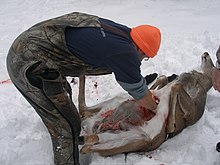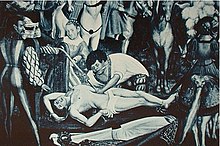Disembowelment
This article needs additional citations for verification. (April 2024) |

Disembowelment, disemboweling, evisceration, eviscerating or gutting is the removal of
Dressing of animals


The removal of internal organs is a typical operation in meat processing also known as dressing.[2] Land animals and birds are typically killed and bled before the dressing. The process of dressing includes the removal of heart, liver and lungs (pluck) as well as disembowelment by an abdominal cut.[3] Disembowelment is typically accompanied by bung dropping or bunging.[4] Bung dropping is the circumcision of the rectum from the carcass and is the first step of the gutting.[4] Puncturing of bowels are avoided during the evisceration. Otherwise, bacteria from the intestinal contents might spread over the carcass.[5] In case of birds, the abdominal cut extends up to the cloaca separating it from the rest of the skin.[6]
Industrial dressing line
A bung dropper is a device used in
Mummification and embalming
Some types of
James Cook, on his second voyage, noted an embalming custom on some of the Pacific islands his crew visited, a custom utilizing transanal evisceration:[11]
We found the body not only entire in every part; but, what surprised us much more, was, that putrefaction had scarcely begun (...); though the climate is one of the hottest, and Tee had been dead above five months.(...) Such were Mr. Anderson's remarks to me, who also told me, on his enquiring into the method of effecting this preservation of their dead bodies, he had been informed, that, soon after their death, they are disemboweled, by drawing their intestines, and other viscera, out at the anus; and the whole cavity is then filled or stuffed with cloth; introduced through the same part(...)
Transanal evisceration of humans
When a portion of the intestinal tract is forcefully pulled from or expelled from the body through the anus, it is referred to as transanal evisceration. Following the first report of transanal evisceration by Brodie in 1827, more than 70 cases have been reported to date, the majority occurring spontaneously in elderly individuals. Straining, chronic constipation, and rectal ulcerations predispose to spontaneous perforation in elderly individuals.[12]
Cases of transanal evisceration of children whilst sitting over uncovered
A person, usually a child, can suffer a similar injury if a heavy weight is applied directly over the abdomen. Large intestine (rectosigmoid) rupture with transanal evisceration has been reported from blunt abdominal trauma and suction injuries. A direct blow or impingement of intestine between the vertebrae and anterior abdominal wall results in sudden increase in the intra-abdominal or intraluminal pressure of the intestine and rupture.[12] The downward pressure forces a portion of the intestine to burst from the anus.
Disembowelment of humans as torture
This section needs additional citations for verification. (August 2023) |

If a living person is disemboweled, it is invariably fatal without major medical intervention. Historically, disembowelment has been used as a severe form of capital punishment. If the intestinal tract alone is removed, death follows after several hours of gruesome pain. The victim will often be fully conscious while the torture is performed if the vital organs aren't damaged, and will be able to see their intestine being removed, but will eventually lose consciousness due to blood loss. However, in some forms of intentional disembowelment, decapitation or the removal of the heart and lungs would hasten the victim's death.[citation needed]
Asia
Vietnam
Various accounts have asserted that during the
Palestine
Two Israeli people were disemboweled during the 2000 Ramallah lynching.
Europe
Romania
In early 1941, during the
Netherlands
On 10 July 1584,
Roman Empire

England

In
William Harrington, Hugh le Despenser the Younger and William Parry are examples of men who were hanged, drawn and quartered – tortured on the rack, hanged until not quite dead, subjected to emasculation, disembowelment and then chopped into quarters.[22]
Germany
From the 15th century, ordinances are retained that threaten with a terrible punishment those who stripped off the bark of a standing tree in the common woods. A typical wording is found in the 1401 ordinance from Oberursel:[23]
"...and whoever is caught stripping off a standing tree, mercy would have been more beneficial to him than the law is; for when law is to be fulfilled, then one is to cut up his stomach at the navel, and pull out a length of the gut. The gut is to be nailed to the tree, and one is keep going around that tree with the person, so long as he still has any part of the gut left in his body."
Americas

Suicide

In
The act of decapitation by a second (kaishaku-nin) was added to this ritual suicide in later times in order to shorten the suffering of the samurai or leader, an attempt at rendering the ritual more humane. Even later the knife was just a simple formality and the swordsman would decapitate before the subject could reach for it. The commission of a crime or dishonorable act was only one of many reasons for the performance of seppuku; others included the atonement of cowardice, as a means of apology, or following the loss of a battle or the surrender of a castle.[citation needed]
The Japanese tradition of seppuku is a well known example of highly ritualized suicide, within a wider cultural world of norms and symbolism. However, reported examples of suicides exist, in which a person performed disembowelment on himself or herself, without any ambient culture of approved, or expected, suicide.[citation needed]
The Spartan king
Roman statesman Cato the Younger committed suicide in Utica, after his side lost to Caesar, by plunging a knife in his own gut, in the dead of night. According to Plutarch, Cato's son heard the commotion from a nearby room, and called a doctor who stitched the wound close; after his son and the doctor left, Cato tore the stitching open with his hand and died. On account of his tragic, highly symbolic suicide, Cato is often termed Uticensis ("of Utica"), in order to differentiate him from his homonymous ancestor, Cato "the Elder" or "the Censor".[citation needed]
In 1593, a suicide occurred in Wimpfen. A young, pregnant woman, who had become a widow a few weeks before, was lying in her bed. She took a large knife, opened her belly in a cross, and threw out the fetus, her own intestines, and dug out her spleen and flung that out as well. She lived for 10 hours after the act, and when the priests sought to bring her a final consolation and blessing, she said it would all be in vain, because she was a daughter of the devil, and was beyond any sort of redemption. Then, she died, was put in a sack, and was thrown in the river. She was affluent, so it was clear that poverty had not driven her to this act.[28]
In 1617, a merchant in the municipality Grossglockau[29] slit up his abdomen so that the intestines fell out; he then pulled out his stomach and threw it on the bed. The chronicler notes he lived long enough to regret his action.[30]
See also
References
- PMID 22061585.
- ISSN 1332-9049.)
{{cite journal}}: CS1 maint: DOI inactive as of January 2024 (link - PMID 11764190.
- ^ a b "At-Home Hog Slaughter". extension.sdstate.edu. Retrieved 15 August 2023.
- S2CID 73414634.
- ^ Engelbrecht, A. (2014). "Slaughter-Bird Production And Product Quality.". Ostrich manual (PDF). Western Cape Department of Agriculture. p. 74.
- S2CID 230599141.
- ^ Stijn, Hofkens (2017). The decontaminating effects of lactic acid on pig-associated Salmonella and Yersinia enterocolitica (PDF). Diss. Ghent University.
- S2CID 125223101.
- ISBN 978-977-424-858-0.
- ^ * Potts, James (1784). The Hibernian Magazine, Or, Compendium of Entertaining Knowledge. Dublin: James Potts. p. 693, col 2. Retrieved 2013-03-16.
- ^ PMID 23493429.
- ^ "Wading Pool Drain Sucks Out Girl's Organ". WSB Atlanta. MINNEAPOLIS. 5 Jul 2007. Archived from the original on 29 June 2011. Retrieved 28 June 2011.
- ^ "Family Reaches Settlement that Guarantees $25 Million Payment". WRAL-TV. RALEIGH. January 14, 1997. Retrieved 29 October 2010.
- ^ Hubbel, John G. (November 1968). "The Blood-Red Hands of Ho Chi Minh". Reader's Digest: 61–67.
- ^ "Off With Their Hands". Newsweek. 15 May 1967.
- ^ ISBN 0-8129-0745-0.
- ISBN 965-308-157-8. For details of the Pogrom itself, see volume I, pp. 363–400.
- ^ ISBN 0-00-719257-6.
- ^ Motley, John L. (1856). The Rise of the Dutch Republic, Vol. 3.
- ^ Foucault, Michel. "The Spectacle of the scaffold.". Discipline and Punish.
- ^ Schama, Simon (26 May 2009). "Simon Schama's John Donne". BBC2. Retrieved 18 June 2009.
- ^ For a number of such ordinances, see * Grimm, Jacob (1854). Deutsche Rechtsalterthümer. Göttingen: Dieterich. pp. 519–20. Retrieved 2013-03-13. German original: "und wo der begriffen wird, der einen stehenden baum schälet, dem wäre gnad nützer dan recht u. wann man deme sol recht thun, soll man ihm seinen nabel bei seinem bauch aufschneiden u. ein darm daraus thun, denselbigen nageln an den stamm u. mit der person herumgehen, so ,lang er ein darm in seinem leib hat"
- ^ i) General comment, with connotations of this being a type of human sacrifice Hübner, Johann (1703). Kurtze Fragen aus der politischen Historia, volume 6. Gleditsch. p. 500. Retrieved 2013-03-13., ii) 8th century description from 772-73, Caesar, Aquilin Julius (1786). Beschreibung des Herzogthum Steyermarks, Volume 1. Gräz: Zaunrith. pp. 88–89. Retrieved 2013-03-13., iii) Danish 1096 retaliation on Wends, by like execution method, Sell, Johann Jakob (1819). Geschichte des Herzogthums Pommern, volume 1. Berlin: Flittner. pp. 88–89. Retrieved 2013-03-13., iv) 1131 pagan attacks on Christians by Wends, Röper, Friedrich L. (1808). Geschichte und Anekdoten von Dobberan in Mecklenburg. Dobberan: Self-published. pp. 111–13. Retrieved 2013-03-13.
- ^ Voigt, Johannes (1827). Geschichte Preussens: Von den altesten Zeiten bis zum Untergange der Herrschaft des Deutschen Ordens. Die Zeit von der Ankunft des Ordens bis zum Frieden 1249, Volume 2. Königsberg: Bornträger. pp. 613–614. Retrieved 2013-03-13.
- ^ Täubel, Gottlob (1796). Allgemeines Historienbuch von den Merkwurdigsten Entdeckungen fremder ehedem ganz unbekannter Länder und Inseln. Vienna: Gottlob Täubel. pp. 206–07. Retrieved 2013-03-13.
- ^ Lauremberg, Peter (1708). Neue und vermehrte Acerra philologica. Frankfurt and Leipzig: Johann A. Plener. p. 985. Retrieved 2013-03-16.
- Zawidow), a woman who had become pregnant by another man than her (absent) husband sought to preserve her honour by cutting out the fetus. Having pulled it out, along with much else, she began screaming of pain, but no one could help her, and she died three days later. Döpler, Jacob (1697). Theatrum Poenarum, volume 2. Leipzig: Friedrich Lanckischen Erben. pp. 313–14. Retrieved 2013-03-16.
- ^ For status as municipality, see:Janssen, Johannes (1896). History of the German People at the Close of the Middle Ages. London: Taylor and Francis. p. 336. Retrieved 2013-03-16.
- ^ Khevenhüller, Franz C. (1723). Annales Ferdinandei, volume 7-8. Leipzig: M.G. Weidmann. p. column 1158. Retrieved 2013-03-16.
